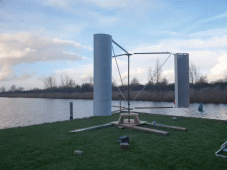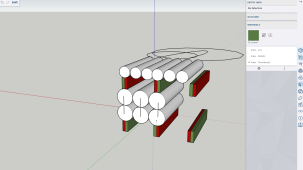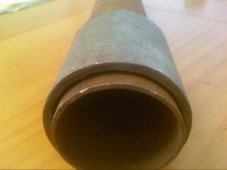You are using an out of date browser. It may not display this or other websites correctly.
You should upgrade or use an alternative browser.
You should upgrade or use an alternative browser.
Building the sickest ® VAWT ever. Brilliant minds unite please!!
- Thread starter brandnewb
- Start date
brandnewb
Going for serious. starting as newb
I mean given that MPPT charge controllers can basically handle any given input to charge any given battery array.
Then that means all bets are off and it is back to where this journey all started. building the sickest ever!!!
Then that means all bets are off and it is back to where this journey all started. building the sickest ever!!!
brandnewb
Going for serious. starting as newb
ahh good to know brother that you are of the growing type. I myself have started growing as well. Yet again like with all of my endevours I start with absolutely no idea of what I am doing.My citrus trees are not happy.
Hedges
I See Electromagnetic Fields!
- Joined
- Mar 28, 2020
- Messages
- 20,675
can you please elaborate?
Slide 23, rated amps (watts) vs. max input volts (model). Also a dollar premium for the 250V model, which handles lowest current.
Probably fewer amps for a given voltage because that is the trade-off in transistors, and cost due to higher voltage capacitors (I would guess).
This would likely not be the case if the higher voltage models were also meant only for higher voltage batteries (fewer amps needed for same wattage.) Which is why GT PV inverters and HV battery inverters are light weight and inexpensive.
Page 18 mentions Clipper. I think I've seen circuit schematics somewhere.
Hedges
I See Electromagnetic Fields!
- Joined
- Mar 28, 2020
- Messages
- 20,675
I mean given that MPPT charge controllers can basically handle any given input to charge any given battery array.
Then that means all bets are off and it is back to where this journey all started. building the sickest ever!!!
Different algorithms for PV vs. wind, maybe vs. hydro.
IV curves and response to change in load differs.
brandnewb
Going for serious. starting as newb
@Warpspeed please resurface once more. I respect that you have das boat like sub surface abilities but now more than anytime in history I hope you are willing to come to the surface again and give some expert feedback on my most radical idea yet.But can one see where I am aiming at?
brandnewb
Going for serious. starting as newb
the best thing in this pdf is, bar none, the made in America quote
the worrying thing though is that they still have not gotten around to secure their website. please note the http instead of the bare minimum these days of https
I tried registering at their forum earlier but was forced to go through a non secure page to do so, so I backed out.
So then I opted to email them directly and warned them about it and asked my question.
If they get this sub par web presence fixed I might end up becoming a midnight fiend.
brandnewb
Going for serious. starting as newb
ok I tried brother to wade through it. Yet I shipwreck once again.Slide 23, rated amps (watts) vs. max input volts (model). Also a dollar premium for the 250V model, which handles lowest current.
Probably fewer amps for a given voltage because that is the trade-off in transistors, and cost due to higher voltage capacitors (I would guess).
This would likely not be the case if the higher voltage models were also meant only for higher voltage batteries (fewer amps needed for same wattage.) Which is why GT PV inverters and HV battery inverters are light weight and inexpensive.
Page 18 mentions Clipper. I think I've seen circuit schematics somewhere.
so in laymans terms. Is going for the 250 classic a good idea in general terms? and in comparison to the 150 classic is there anything to worry about?
Hedges
I See Electromagnetic Fields!
- Joined
- Mar 28, 2020
- Messages
- 20,675
If your max voltage remains low enough for the Classic 150, it is the better deal - lower cost and higher output.
If your voltage would ever exceed "Hyper Voc" (they have some headroom in the protetion) then you need higher voltage model.
Make sure you never spike voltage too high. Spinning inductive generator could do that. Electronic clamp to clip voltage, and something that prevents the protection circuit from overheating. Maybe after electronic clamp (voltage switch to resistive load?) short the generator out as electrical break. Manual reset to avoid cycling and overheating.
If your voltage would ever exceed "Hyper Voc" (they have some headroom in the protetion) then you need higher voltage model.
Make sure you never spike voltage too high. Spinning inductive generator could do that. Electronic clamp to clip voltage, and something that prevents the protection circuit from overheating. Maybe after electronic clamp (voltage switch to resistive load?) short the generator out as electrical break. Manual reset to avoid cycling and overheating.
brandnewb
Going for serious. starting as newb
nah, our max voltage will be like 3megavolts at 0.001 RPM once I am done with this damned alternator.
I challange anyone that can build an MPPT controller for that sweet sci fi
I challange anyone that can build an MPPT controller for that sweet sci fi
brandnewb
Going for serious. starting as newb
I think I can do that. I mean all I need to do then is first setup the turbine and see it spin at 3m/s. then design the alternator to give at least 48V+30$ at that rpm. I really do not think that things will get so out of hand that the turbine will start spinning so fast under load that it will go above 150V.If your max voltage remains low enough for the Classic 150, it is the better deal - lower cost and higher output.
But the clipper can make sure not to blow up the controller.
Does this make sense? Or should I still worry about the turbine spinning about 50% slower than when it is not under load in the scenario of it being directly hooked up to the battery?
brandnewb
Going for serious. starting as newb
no it does not make sense. Here I go again with this archaic thkning in where the alternator needs to be mateched. No MPPT to the rescue.
So hmmm how to avoid the damned turbine/alternator going over 150 Voc
So hmmm how to avoid the damned turbine/alternator going over 150 Voc
brandnewb
Going for serious. starting as newb
I think clipperOr buy "Clipper"
brandnewb
Going for serious. starting as newb
midnite on paper is the best. But nearly a week after my first email to them still no response.
Ahh of course!! it is the holiday season. (an auto response stating out of office would have been nice though, making me think this midnigt crew is rather down to earth like we are. No corporate suit and no nonsense and no big shiny office)
So everyone, all the best for next year. I mean it should not take much to become a better year than this was does it?
Ahh of course!! it is the holiday season. (an auto response stating out of office would have been nice though, making me think this midnigt crew is rather down to earth like we are. No corporate suit and no nonsense and no big shiny office)
So everyone, all the best for next year. I mean it should not take much to become a better year than this was does it?
brandnewb
Going for serious. starting as newb
I have a small update and question.
The turbine spun rather scary recently in very turbulent wind up to 6m/s. I would share but can't post videos.
With scary I meant that the current column (central steel tube) of 3m length x 48.3mm diam x 2.9mm thickness was bending at the top. The base I have rather strong at the moment.
I am considering to replace the column with something less likely to bend as to invoke more confidence things wont swing and sway apart too quickly when we have good wind.
I have several options;
diam in mm x thickness in mm
* 57 X 4
* 76.1 X 4
* 76.1 X 5
* 88.9 X 5
* 114.3 X 6.3
Now there are larger sizes available but then the price per meter increases massively.
I am opting for either 88.9 or 114.3
Is there anyone that has a bit of experience with steel and can advice?
For example is the stiffness of a steel tube more dependent on the thickness or more dependent on the diameter or are they equally important?
@Hedges, I realize you are advising to use guy wires attached to the top of the turbine but I see that as a last resort and first I'd like to see how far I can get without them.
The turbine spun rather scary recently in very turbulent wind up to 6m/s. I would share but can't post videos.
With scary I meant that the current column (central steel tube) of 3m length x 48.3mm diam x 2.9mm thickness was bending at the top. The base I have rather strong at the moment.
I am considering to replace the column with something less likely to bend as to invoke more confidence things wont swing and sway apart too quickly when we have good wind.
I have several options;
diam in mm x thickness in mm
* 57 X 4
* 76.1 X 4
* 76.1 X 5
* 88.9 X 5
* 114.3 X 6.3
Now there are larger sizes available but then the price per meter increases massively.
I am opting for either 88.9 or 114.3
Is there anyone that has a bit of experience with steel and can advice?
For example is the stiffness of a steel tube more dependent on the thickness or more dependent on the diameter or are they equally important?
@Hedges, I realize you are advising to use guy wires attached to the top of the turbine but I see that as a last resort and first I'd like to see how far I can get without them.
Warpspeed
Solar Wizard
For stiffness definitely go larger diameter.
Thicker only makes it very heavy, and you might need a crane to get the job done.
You can go quite thin, but if you go too thin it will be quite stiff, but may crumple before it bends very far.
Hint, its common practice for power poles and other self supporting masts to have about 25% below the ground and 75% above ground.
You are going to have EXTREME wind loading by design, so that might be a minimum to consider.
Maximum bending stress on the pipe is going to be right at ground level, and that is also where its going to rust away first, or suffer from metal fatigue, and eventually snap off.
What I would do, would be to sink a galvanized steel water pipe into the ground, with a concrete pad at the top, so water can easily run off away from the pipe.
Pipe is always measured by inside diameter, and the inside bore of water pipe is also always made very slightly oversized.
Make the actual mast from round tube (not pipe).
Tube is structural, and is always measured by exact outside diameter, and is available in a wide range of different wall thicknesses. That will keep the weight and the cost down.
So the idea is (for example) a three inch tube will be a loose sliding fit inside a three inch pipe. Or whatever sizes you finally decide to use.
Concrete the heavy galvanized pipe into the ground so there is maybe a foot or two sticking out. That is where its going to rust away first, so galvanized water pipe should last a fair while. That is also an ideal place to mount a thrust bearing.
Slip the lighter gauge vertical tube inside the below ground pipe.
If the upper tube part does fail in a storm, you just slide it out and replace it.
Thicker only makes it very heavy, and you might need a crane to get the job done.
You can go quite thin, but if you go too thin it will be quite stiff, but may crumple before it bends very far.
Hint, its common practice for power poles and other self supporting masts to have about 25% below the ground and 75% above ground.
You are going to have EXTREME wind loading by design, so that might be a minimum to consider.
Maximum bending stress on the pipe is going to be right at ground level, and that is also where its going to rust away first, or suffer from metal fatigue, and eventually snap off.
What I would do, would be to sink a galvanized steel water pipe into the ground, with a concrete pad at the top, so water can easily run off away from the pipe.
Pipe is always measured by inside diameter, and the inside bore of water pipe is also always made very slightly oversized.
Make the actual mast from round tube (not pipe).
Tube is structural, and is always measured by exact outside diameter, and is available in a wide range of different wall thicknesses. That will keep the weight and the cost down.
So the idea is (for example) a three inch tube will be a loose sliding fit inside a three inch pipe. Or whatever sizes you finally decide to use.
Concrete the heavy galvanized pipe into the ground so there is maybe a foot or two sticking out. That is where its going to rust away first, so galvanized water pipe should last a fair while. That is also an ideal place to mount a thrust bearing.
Slip the lighter gauge vertical tube inside the below ground pipe.
If the upper tube part does fail in a storm, you just slide it out and replace it.
Last edited:
Warpspeed
Solar Wizard
Here is a piece of two inch water pipe, and a rusty old piece of two inch exhaust tubing I found out in the shed.
Its a nice easy sloppy fit, about 2mm clearance by eye.
That exhaust tubing is terribly thin, only about 1.6mm, but you can get much larger diameters and wall thicknesses in inch sizes.
Its a nice easy sloppy fit, about 2mm clearance by eye.
That exhaust tubing is terribly thin, only about 1.6mm, but you can get much larger diameters and wall thicknesses in inch sizes.
Attachments
brandnewb
Going for serious. starting as newb
Here is a piece of two inch water pipe, and a rusty old piece of two inch exhaust tubing I found out in the shed.
Its a nice easy sloppy fit, about 2mm clearance by eye.
That exhaust tubing is terribly thin, only about 1.6mm, but you can get much larger diameters and wall thicknesses in inch sizes.
also nice to see some people still apply the clean desk policy. something I abandoned years ago ;(
brandnewb
Going for serious. starting as newb
I have made an animated gif from the turbine while spining. this was before the bending really became more pronounced because the wind picked up more.
But you can already see it bending at the top.

with the diagonal top arm supports the blades no longer need to be balanced, even though these are, as they will then basically hang and gravity will make sure they can't fall over.
But you can already see it bending at the top.

with the diagonal top arm supports the blades no longer need to be balanced, even though these are, as they will then basically hang and gravity will make sure they can't fall over.
Similar threads
- Replies
- 260
- Views
- 15K





